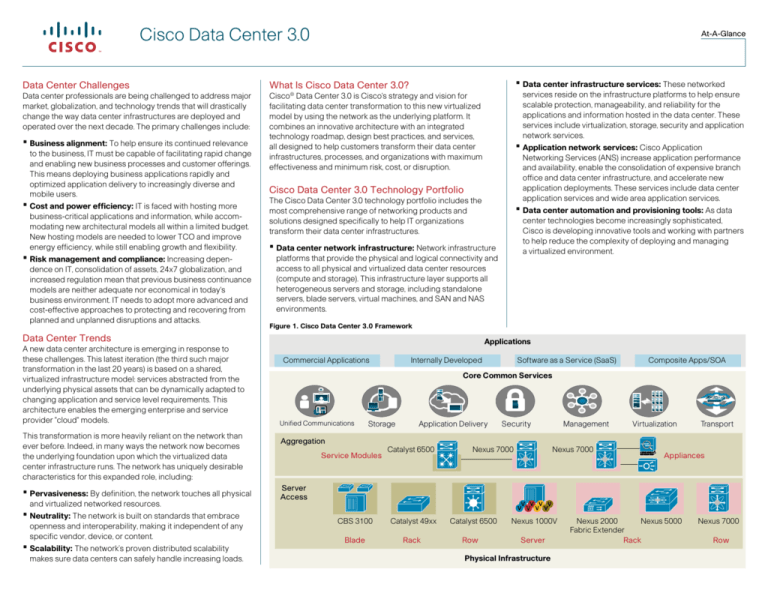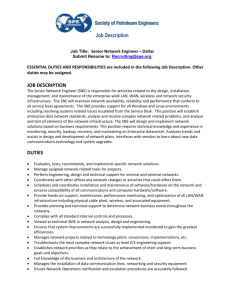
Cisco Data Center 3.0
At-A-Glance
•Data center infrastructure services: These networked
Data Center Challenges
What Is Cisco Data Center 3.0?
Data center professionals are being challenged to address major
market, globalization, and technology trends that will drastically
change the way data center infrastructures are deployed and
operated over the next decade. The primary challenges include:
Cisco® Data Center 3.0 is Cisco's strategy and vision for
facilitating data center transformation to this new virtualized
model by using the network as the underlying platform. It
combines an innovative architecture with an integrated
technology roadmap, design best practices, and services,
all designed to help customers transform their data center
infrastructures, processes, and organizations with maximum
effectiveness and minimum risk, cost, or disruption.
•Business alignment: To help ensure its continued relevance
to the business, IT must be capable of facilitating rapid change
and enabling new business processes and customer offerings.
This means deploying business applications rapidly and
optimized application delivery to increasingly diverse and
mobile users.
•Cost and power efficiency: IT is faced with hosting more
business-critical applications and information, while accommodating new architectural models all within a limited budget.
New hosting models are needed to lower TCO and improve
energy efficiency, while still enabling growth and flexibility.
•Risk management and compliance: Increasing depen-
dence on IT, consolidation of assets, 24x7 globalization, and
increased regulation mean that previous business continuance
models are neither adequate nor economical in today's
business environment. IT needs to adopt more advanced and
cost-effective approaches to protecting and recovering from
planned and unplanned disruptions and attacks.
This transformation is more heavily reliant on the network than
ever before. Indeed, in many ways the network now becomes
the underlying foundation upon which the virtualized data
center infrastructure runs. The network has uniquely desirable
characteristics for this expanded role, including:
•Pervasiveness: By definition, the network touches all physical
and virtualized networked resources.
•Neutrality: The network is built on standards that embrace
openness and interoperability, making it independent of any
specific vendor, device, or content.
•Scalability: The network’s proven distributed scalability
makes sure data centers can safely handle increasing loads.
•Application network services: Cisco Application
Networking Services (ANS) increase application performance
and availability, enable the consolidation of expensive branch
office and data center infrastructure, and accelerate new
application deployments. These services include data center
application services and wide area application services.
Cisco Data Center 3.0 Technology Portfolio
The Cisco Data Center 3.0 technology portfolio includes the
most comprehensive range of networking products and
solutions designed specifically to help IT organizations
transform their data center infrastructures.
•Data center automation and provisioning tools: As data
center technologies become increasingly sophisticated,
Cisco is developing innovative tools and working with partners
to help reduce the complexity of deploying and managing
a virtualized environment.
•Data center network infrastructure: Network infrastructure
platforms that provide the physical and logical connectivity and
access to all physical and virtualized data center resources
(compute and storage). This infrastructure layer supports all
heterogeneous servers and storage, including standalone
servers, blade servers, virtual machines, and SAN and NAS
environments.
Figure 1. Cisco Data Center 3.0 Framework
Data Center Trends
A new data center architecture is emerging in response to
these challenges. This latest iteration (the third such major
transformation in the last 20 years) is based on a shared,
virtualized infrastructure model: services abstracted from the
underlying physical assets that can be dynamically adapted to
changing application and service level requirements. This
architecture enables the emerging enterprise and service
provider "cloud" models.
services reside on the infrastructure platforms to help ensure
scalable protection, manageability, and reliability for the
applications and information hosted in the data center. These
services include virtualization, storage, security and application
network services.
Applications
Commercial Applications
Internally Developed
Software as a Service (SaaS)
Composite Apps/SOA
Core Common Services
Unified Communications
Storage
Aggregation
Service Modules
Application Delivery
Catalyst 6500
Security
Nexus 7000
Management
Nexus 7000
Virtualization
Transport
Appliances
Server
Access
CBS 3100
Catalyst 49xx
Blade
Rack
Catalyst 6500
Row
Nexus 1000V
Server
Physical Infrastructure
Nexus 2000
Nexus 5000
Fabric Extender
Rack
Nexus 7000
Row
Cisco Data Center 3.0
Cisco Data Center 3.0 People and Processes
Cisco is also helping customers to plan, design, and deploy
Data Center 3.0 technologies more rapidly through new data
center processes and initiatives. Cisco is taking a leading role in
helping to provide the skill sets and best practices required for
transparent collaboration across traditionally siloed technology
domains. These include:
• Expanded Cisco Data Center Career Certification
• Cisco Data Center Assurance Program (DCAP) Design Best
Practices
• Cisco Advanced Services and Support
• Cisco Data Center Partner Specialization Program
Partnering for Complete, Validated Customer
Solutions
The Cisco Data Center 3.0 architecture provides an adaptable
and neutral foundation for a wide ecosystem of other partners
and vendors to offer complete data center solutions. These
partners include market leaders such as EMC, Hewlett Packard,
HDS, IBM, Oracle, Microsoft, SAP, and VMware as well as a
wide range of specialist providers that can facilitate a smooth,
integrated delivery of data center infrastructures customized to
unique requirements.
At-A-Glance
• Utility: An internal enterprise-class cloud, based on the
Additional Information
previous architectural model allows enterprise data centers
to offer clients a service provider model with pay as you go
billing, tiered service levels and provision-to-order
• Market: By extending internal clouds to operate inter-cloud
Cisco invites you to learn more about Cisco Data Center 3.0.
Let us help you build a pragmatic roadmap that addresses both
your current data center challenges as well as the desired endstate for your future data center.
across datatcenters and 3rd party service providers, IT can
move services and data to the most appropriate hosting
environment, based on market forces and business
requirements.
• Cisco Data Center 3.0: www.cisco.com/go/datacenter
• Cisco data center design best practices: www.cisco.com/go/
Figure 2. Data Center 3.0 Evolution Path
Location
Freedom
HW
Freedom
Consolidation Virtualization
Provisioning
Freedom
Automation
ciscoitatwork/data_center/index.html
Business
Process
Freedom
Utility
dcdesignzone
• Cisco data center services: www.cisco.com/go/dcservices
• Cisco IT data center experiences: www.cisco.com/web/about/
Market
Inter-Cloud
Enterprise-Class Clouds
Unified Computing
Cisco Data Center 3.0 Roadmap
With the Cisco Data Center 3.0 roadmap, IT architects can take
an evolutionary approach to migrating from the traditional customized siloed hosting environments to a utility infrastructure
market model. This will not happen all at once, but through a
planned step-by-step approach that is accompanied by clear
immediate benefits along the way.
The Data Center 3.0 roadmap encompasses the following steps:
• Consolidation: The deployment of a data center network
architecture that allows data centers and branches as well
as the server, storage and network resources they contain to
be standardized and consolidated for improved operational
efficiencies, greater utilization and enhanced resilience.
• Virtualization: The introduction of a unified fabric, optimized
for the hosting and orchestration of virtualized server, storage
and network resources ensures greater IT responsiveness
and application availability.
• Automation: The deployment of a unified computing architecture allows infrastructure simplification through pre-designed
virtualization architecture, extended lifecycle of capital assets
and scalable rightsizing as business requirements change.
Unified Fabric
Data Center Networking
Next Steps
While all IT organizations are faced with pressing data center
challenges that can include application and data growth,
facilities limitations, or underutilized resources, it is important to
take a big picture approach to addressing today's data center
infrastructure. For this reason many IT organizations, including
Cisco's own, have developed a longer term strategy that
incorporates the following steps:
• Develop the desired end-goal data center infrastructure
model aligned with business objectives
• Identify the primary near-term data center projects and
develop a plan to implement them in the context of the longer
term architecture
• Engage with Cisco and our partners to learn how Cisco Data
Center 3.0 can help you achieve your data center goals
Copyright © 2009 Cisco Systems, Inc. All rights reserved. Cisco, Cisco IOS, Cisco Systems, and the Cisco Systems logo are registered trademarks or trademarks of Cisco Systems, Inc. and/or its affiliates in the United States and certain other countries. C45-509458-00 01/09







